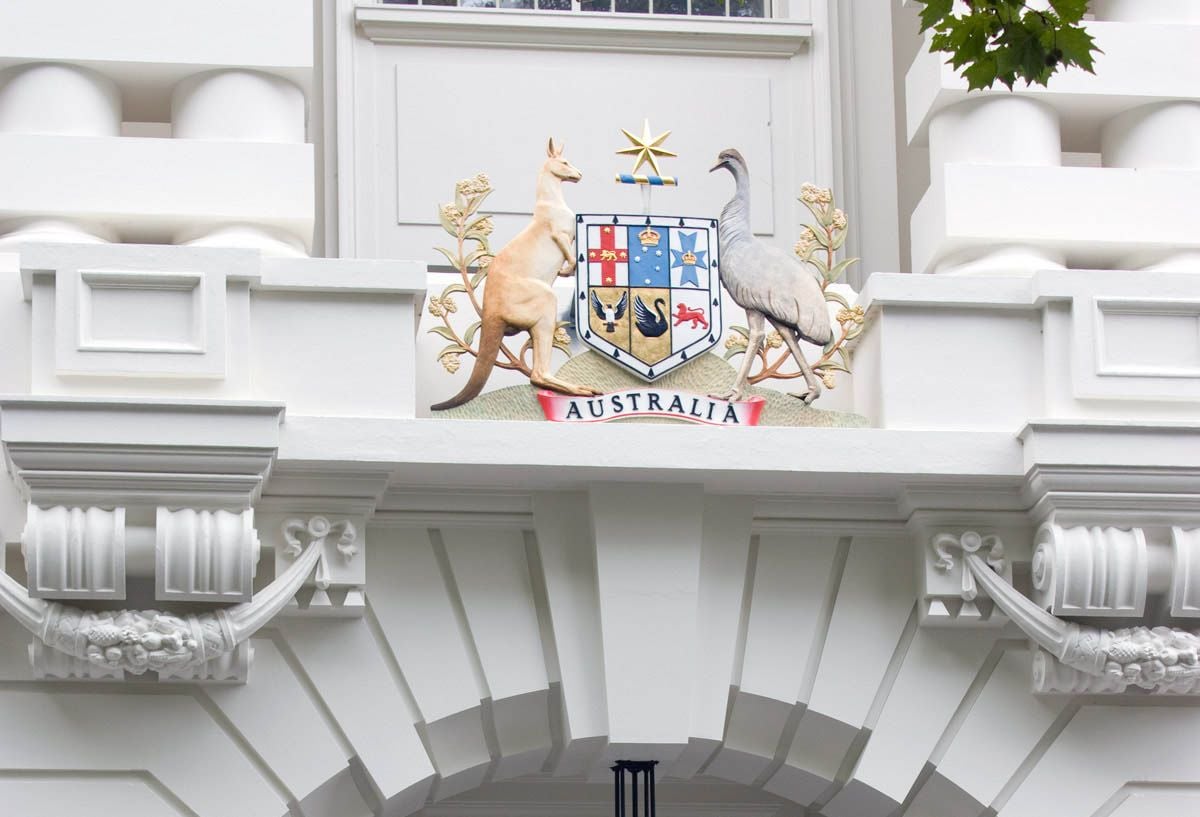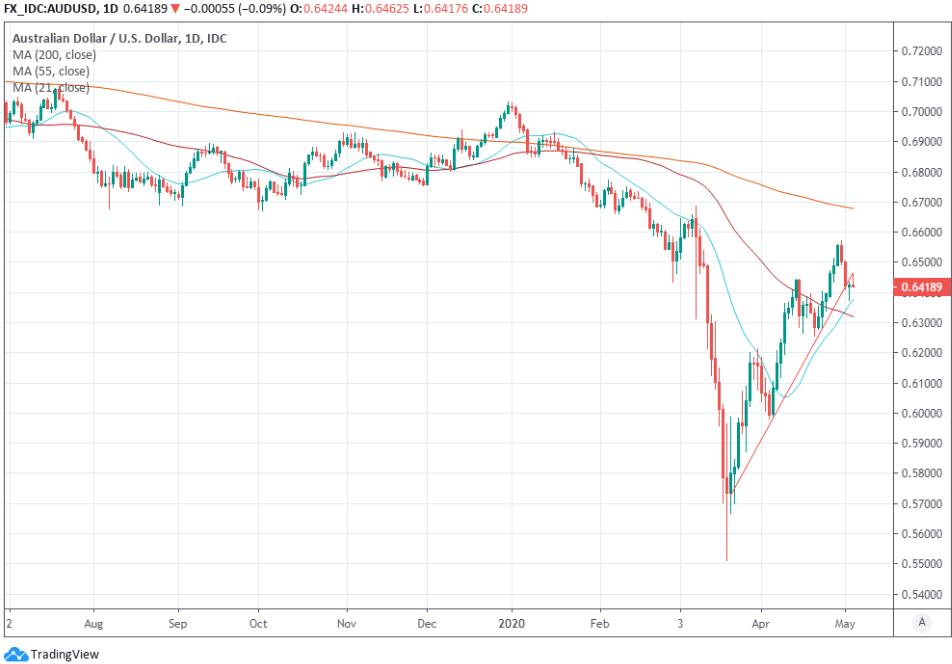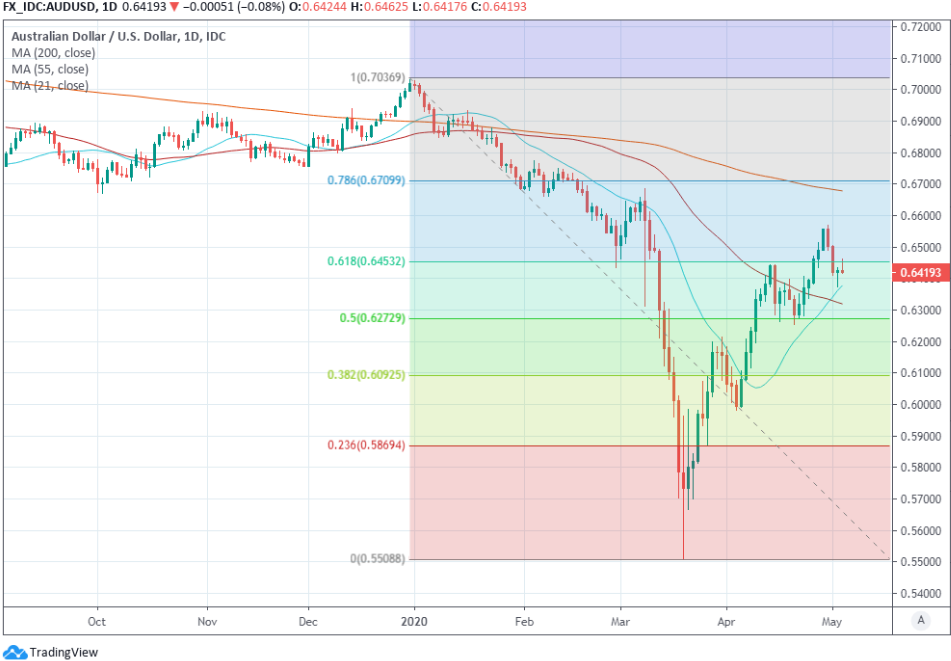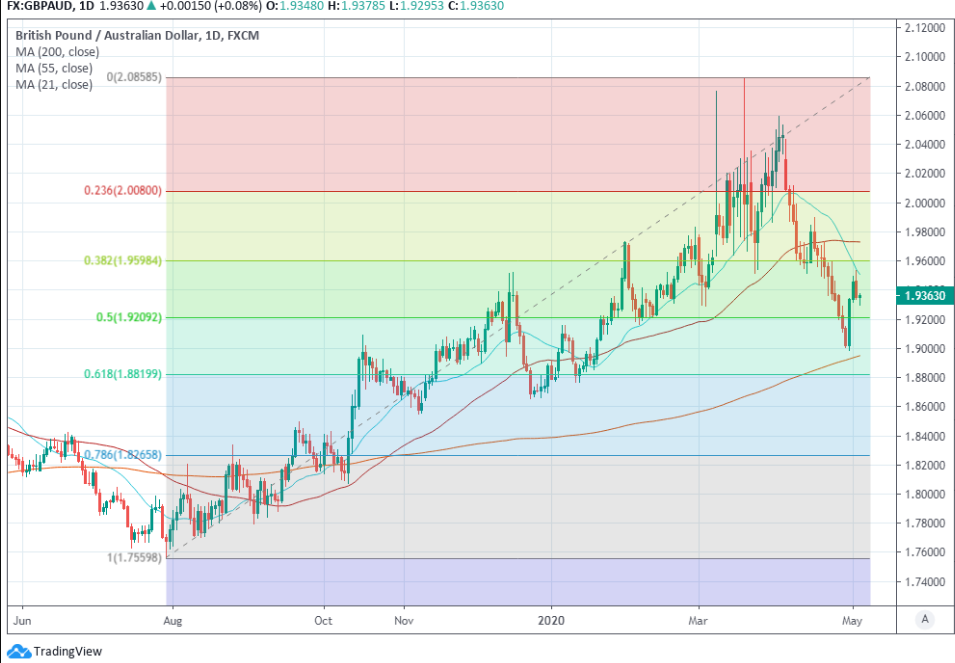Australian Dollar has "Topped Out", Technical Analyst Says, as Others Look to Sell on Rallies
- Written by: James Skinner
- AUD/USD looks like it has topped out says Commerzbank.
- As Westpac reiterates "sell on rallies" stance for AUD/USD.
- MUFG says AUD most "overbought" G10 currency this year.
- AUD/USD correction furthers GBP/AUD rebound short-term.

Image © Rexness, Accessed Flickr, Reproduced under Creative Commons licensing
- GBP/AUD spot at time of writing: 1.9325
- Bank transfer rates (indicative): 1.8649-1.8784
- FX specialist rates (indicative): 1.9035-1.9151 >> More information
The Australian Dollar looks like topped out on the charts after a strong eight percent rally through April, technical analysts say, at a point when a fresh bout of tensions between the U.S. and China risks weighing on the antipodean unit and furthering a corrective Pound-Australian Dollar rate rebound.
Australia's Dollar rose more than 8% against the U.S. greenback and Pound last month as the antipodean country made swifter progress in containing its own coronavirus infection while investors looked ahead to a possible reopening of other major economies too. But May typically brings a seasonal shift in financial flows that disadvantages the Aussie and this year has been no different, with the currency appearing to top out last week on the first day of the new month.
"The high last week of .6570 was not been confirmed by the daily RSI and the market has eroded the short term uptrend. This increasingly looks like the market has topped Below here minor support is seen along the 55 day moving average at .6320 and also at the .6265/55 recent lows. Should the .6265/55 support area give way, the .6213 late March high and then .5981, the current April low, would be back in focus," says Karen Jones, head of technical analysis for currencies, commodities and bonds at Commerzbank.

Above: AUD/USD rate, shown at daily intervals, erodes upward sloping trendline drawn amid rebound from 2020 losses.
Australia's Dollar edged higher against the greenback Monday and Tuesday but ended last week on its back foot and "eroded the short term uptrend" in a move that can be seen on the chart above. The erosion indicates a potential loss of momentum and comes at a point when new competing fundamental influences are complicating the outlook for the currency.
The Reserve Bank of Australia (RBA), which is typically averse to a strong Aussie, gave the currency a free pass on Tuesday when it acknowledged risks facing the economy but passed up the opportunity to comment on recent moves in exchange rates. This is after having quickly tapered off its once-large A$5bn per day government bond purches under its maiden quantitative easing programme, which had crushed bond yields and weighed on the currency in March, in what is a positive development for the Aussie.
"We see the A$ as being expensive to fair value, that it remains a sell on strength to 0.6550, and it should be closer to 0.62. However, the sense that the RBA is done from a policy perspective and that we are moving towards reopening the Australian economy may support sentiment in the short term," says Robert Rennie, head of financial market strategy at Westpac.
A swift curtailment of RBA bond market intervention, a domestic coronavirus problem that's now all-but non-existent and moves to reopen the economy alongside the U.S. and most major European countries are all bullish for the Aussie. But the prospect of fresh U.S.-China trade tensions and slow as well as shallow global economic recovery are clear headwinds that argue in favour of the idea that the Australian Dollar may have topped out.

Above: Overbought AUD/USD rate fails to sustain break above 61.8% Fibonacci retracement of 2020 downtrend.
U.S officials said Monday there'll be no "punitive measures" imposed on China for its handling of the initial coronavirus outbreak so long as the world's second largest economy sticks to the terms of the trade agreement signed in January, but this was only after other named officials said the White House would be accelerating efforts to remove international supply chains from the country in the months ahead. That course of action is not necessarily precluded by Monday's pledge to avoid "punitive measures" like tariffs on goods exports.
"The Australian dollar fell sharply in the initial response to COVID-19 hitting an intra-day low of 0.5510 on 19th March. However, it has since staged a remarkable “v” shaped recovery. It is currently the most overbought G10 currency according to our technical models suggesting that recent gains may have gone too far, too fast in light of the still challenging environment," says Lee Hardman, a currency analyst at MUFG.
The U.S. alleges the virus escaped from a research lab in Wuhan near the 'wet market' the government claims as the source of the outbreak, and further alleges that China's lack of candour over the problem it was facing deprived other countries of valuable time in which preparations could have been made, potentially leading some lives to be saved. The global coronavirus death toll surpassed 250k this week, with almost half of them in the U.S. and UK while a substantial majority are to be found split between the U.S., UK and Europe.
Meanwhile, Reuters reported that Chinese government documents show Beijing expects to face international criticism and hostilities over the coronavirus that have not been directed at the Asia Pacific country since the 1989 Tiananmen massacre in which Chinese citizens were shot and ran over by the armed forces for having protested against the regime and in favour of a democratic future. The piece alleges that Beijing sees a risk of armed conflict with Washington.
"Geopolitical tensions are escalating rapidly far beyond the extent to which markets are pricing for - apart from US Treasury yields, where the 2-year is hovering around a record low of just 18bp. An extra 10% US tariff on Chinese goods at this stage, as a random example, would actually be a very benign outcome given the rhetoric being flourished. Of course, one can make the point that USD/CNH is hardly moving. Yet as was stressed yesterday, this is not really a market. When it starts moving sharply we know that at least one sabre is already being used," warns Michael Every, a strategist at Rabobank.

Above: Pound-Australian Dollar rate bounces off 200-day moving-average, could target 1.96-to-2.03 range.
A fresh set-to between the U.S. and China would be a clear negative for the Aussie and more so than it would be for Pound Sterling given Australia's economic dependence on exports to China, which is a relationship that tends to put the AUD/USD rate under pressure whenever the USD/CNH rate starts to rise. China committed to keep the USD/CNH rate relatively stable in the January trade deal with the U.S. but if that pact falls apart in the coming weeks then the downside risks to the Aussie would increase.
Further hostile rhetoric between the two sides might help to extend the tentative rebound higher seen in the Pound-Australian Dollar rate since the beginning of May, when the exchange rate bounced off its 200-day moving-average near 1.89 after a steep April slump. The GBP/AUD rate always closely matches the sum of GBP/USD over AUD/USD and if the latter suffers more downside from renewed geopolitical tensions it would likely be positive for GBP/AUD.
"GBP/AUD is weaker this morning, due to risk appetite largely benefiting the Australian Dollar, which is also cheering the recovery in oil prices. As a commodity currency, the AUD is positively correlated with oil prices, therefore will often appreciate if oil prices rise. The possibility of new tariffs between the US and China may limit this oil recovery though as further trade restrictions lead to less demand for crude and crude products. Furthermore, as China is Australia’s number one trading partner by far, a weakness of its economy will likely hurt Australia’s too and weigh on the value of the Aussie dollar," says George Vessey, a currency strategist at Western Union Business Solutions.
Westpac looks for Sterling to top out somewhere between 1.96 and 1.98. Pound Sterling Live suggested in an editorial last week the correction might put it somewhere between 2.00 and 2.0333 before Sterling turns lower again.
The UK will be the last European economy, if not major economy in the world, to exit 'lockdown' and also faces being weighed down by fresh Brexit risks later in May or June unless an extension of the Brexit transition period is agreed upon before the end of next month. That could ensure that once beyond the very short-term, gravity begins to pull the Pound-Australian Dollar rate lower again.




